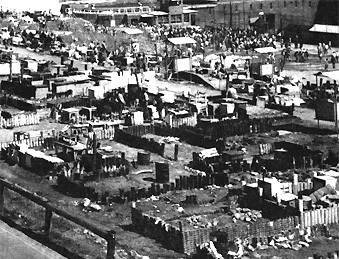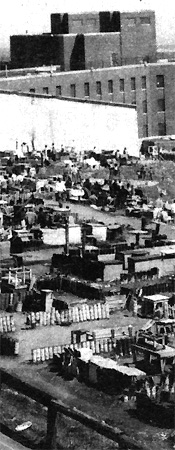
A detail from right half of 1972 Clinton CF report photo viewing courts from basketball level.
(part 6: design implications of this analysis) |
||||||
|
by Ron Roizen It should be mentioned first that the courts represent the culmination of an evolutionary process in which many details of the strain between staff goals and inmate goals were worked out. The mere fact of the uniqueness of this system should argue against the one-shot introduction of this kind of institution to other prisons. At the same time the courts serve to explode several myths . . . . What we have called "technical contraband" (. . . objects necessary to the courts' household functions) have not proved to be too dangerous to be allowed in the yard of a maximum security institution. Possession of these articles, however, is not now a problem precisely because the courts system presents an altered context and an altered meaning for them.
Nevertheless, it is likely that few inmates would prefer to see the courts removed, regardless of their reference or orientation. The diffusion of leadership effected by the courts system may also serve to muffle the possibilities of inmate-wide action, a feature of them that makes their existence problematic for the formation of broadbased in-prison action. Likewise, the existence of a stable hierarchy in the courts no doubt serves to influence the socialization of inmates to the rigors and the tricks of prison life. The description and history of the courts leads us to believe that they arose out of a combination of necessary conditions, including
We have also suggested that the signs of decline in the courts may be an outgrowth of shortened sentences, increasing politicization of the prison scene. The viability of the courts, we have suggested, is dependent upon and reinforces interests' overlap between the staff and the inmates. When, for whatever reason, the overlap is in decline, the courts system too will decline, it is claimed. We have argued that the deprivation reduction aspects of the courts are relatively small, while at the same time providing some simple pleasures to the inmates. The physical arrangements of prison life would seem to be of lesser importance than the structural implications that spring from confinement and the loss of autonomy to a total institution. Much of what we have discussed suggests that the courts system is not likely to be easily transplanted to another institution, although the creation of new courts in the South Yard may be a possibility. Standing as it does as the focal point of the inmates informal interactions, the subdivision of the population, thereby retaining those informal groups which are stable and equilibrious to the institution.
One is quite naturally led to wonder whether the courts system could be expanded to provide the structural basis of a new form of inmate prison organization in this prison. In this regard, however, it is well to remember that the solidarity of the courts is in part an artifact of the current system of prisonwide organization. Expansion to broader goals might disrupt the system or strain it too far. . . . elevating the courts from a recreational to an organizationally central institution may place control of several things now left to inmates more in the hands of the administration -- recruitment patterns and practices for example. This consequence may rob the courts of the very things that make them strong in their present context. On the other hand it is always safest to recommend caution or no change when speaking of social institutions, and functional analysis can always provide many reasons for leaving things the way they are. In this case, however, I think it is easy to see the courts as more than they actually are. They are not families, they are not fraternity groups as in colleges, they are not in other words, institutions that can be evaluated as if they did not exist inside the walls of a maximum security penitentiary. For most, the courts are a small matter next to the Wall. Thus it would seem that while the courts have achieved something of an equilibrium within Clinton Prison, they are not really either strong enough or independent enough of the larger prison context, and the larger community context, to be manipulated for large ends. Let me speak to the splitting of the institution for a moment. At present, the courts are used by virtually everyone at once. This serves as a small security function because tampering is more difficult when everyone is there. I do not know how important this is; but the plucking of one's prize tomato from his garden when others are using the area might present a problem out of proportion to the cause. Obviously, split court ownership where different membership groups use the same court at different times is out of the question, I think. The idea behind the courts is not the courts themselves but their property right meanings. Developing another system of courts in the South Yard is a possibility, but this will have to cover much history quickly. Moreover, the courts cannot be architect built, I think, so a period of evolution will be necessary. The discussion of the nine rules should give some idea of the kinds of problems which may occur although, of course, other problems are possible too.
The depopulation of the courts is another issue that naturally arises from the depopulation of the prison, the splitting of the population, or whatever. The key to the courts, I think, is their capacity to involve the creative talents of anyone confronted with raw materials and possibilities. They appeal to that "vacant lot" possibility that is in all of us. In anticipating the results of depopulation, therefore, we suggest that the provision of diverse resources may be the key to the re -establishment of stable,courts. Expanded terrain poses two problems however:
In part, these are the same problem. Let me explain. Larger land holding and the tilling of more ground and the accumulation of more property may tend to tip the balance away from the staff in terms of their monopoly on the reward system. Thus, we may find the introduction of restrictive rules in counterpoint. The present distribution of court sizes, moreover, may play some role in the precise kind of solidarity they create. Finally, the removal of the competing courts may inadvertently remove part of the reason for the courts in the first place -- viz. , insulation from other inmate groups. The force of this external input is not known, but should be kept in mind. |
| <-- previous | [parts list] | next ---> |


